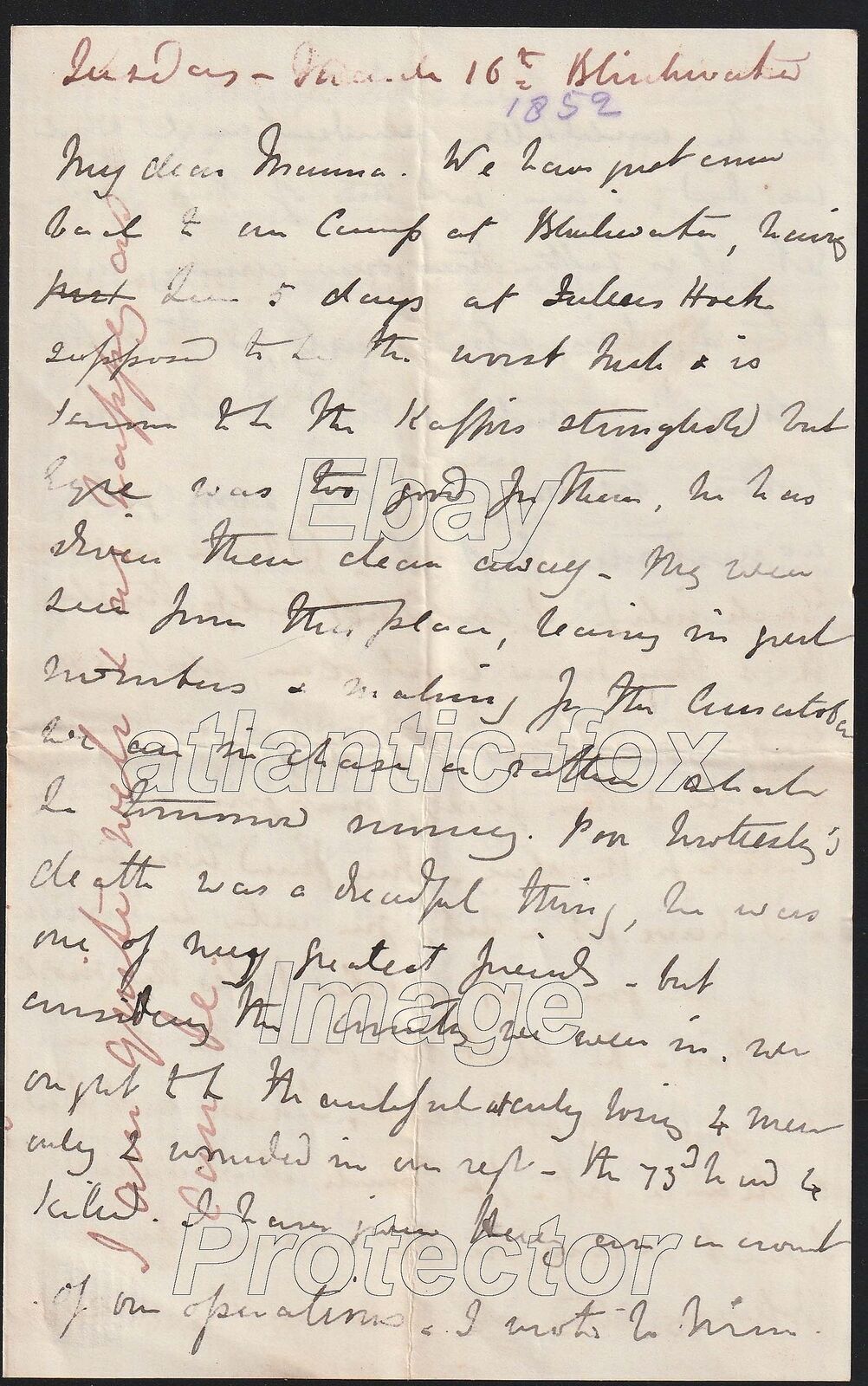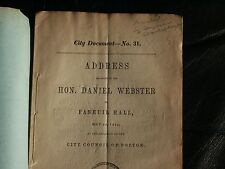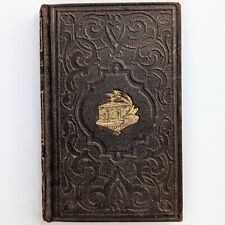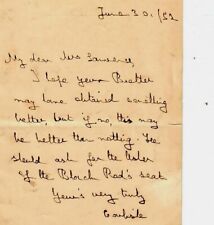1852 RARE KAFFIR WARS, Campaign letter Ensign ARTHUR E. V. PONSONBY 43rd Regt For Sale

When you click on links to various merchants on this site and make a purchase, this can result in this site earning a commission. Affiliate programs and affiliations include, but are not limited to, the eBay Partner Network.
1852 RARE KAFFIR WARS, Campaign letter Ensign ARTHUR E. V. PONSONBY 43rd Regt:
$822.64
1852 RARE KAFFIR WARS, Campaign letter Ensign ARTHUR E. V. PONSONBY 43rd RegtThis product data sheet is originally written in English.1852 Africa, A RARE KAFFIR WARS, Campaign letter from Ensign ARTHUR E. V. PONSONBY serving in the 43rd Regt Light Infantry under Lieutenant-colonel William Eryes Column of the 73rd. A rare and descriptive 4 page letter, dated \"Tuesday March 16th, Blinkwater, detailing his campaigning, regiment losses, fighting, etc. etc. I have done a Transcription of the letter below, difficult hand to 16th- Blinkwater -1852 Mr Dear Mamma, We have just come back to our Camp at Blinkwater, having past been 5 days at Fullers Hoek supposed to be the worst hoek & is known to be the Kaffir\'s stronghold, but Eyre was to good for them, he has driven them clear away. My men leave from this place, leaving in great numbers & making for the Amatolas. We are in chase or rather start to morrow morning. - Poor Wrottesley (Lieutenant the Hon. H. Wrottesley, 43rd Light Infantry) death was a dreadful thing, he was one of my greatest friends - but considering the country we were in, we ought to be thankful at only losing 4 men only 2 wounded in our Regt. - the 73rd had 4 killed. I have given Henry our account of our operations & I wrote to him as he would better understand what we did. I am not tired of this work yet, it is rather tiresome, coming in late & getting up so early, & the batts whizzing about at first makes one rather nervous, but one soon gets accustomed to it all- ( I have no new black ink). I could not help thinking that this time last year, about 3 or 4 in the morning, coming home from a ball & this year, just going out on Patrol for the day - My friend Annesley & I have got a bet, you will be horrified if I tell you - it is who kills the most Kaffir\'s- he shot his first the other day a very good shot, I have not had a chance yet- You think it I dare say a great shame shooting women, but the following story will show you they deserve it -although they never ever shoot except by accident - the Bandmaster of 74th some time ago was taken prisoner, (...text scribbled through....) the Kaffirs cut him off as he foolishly left the column, they gave him over to the women & the women stabbed him all over with assegai\'s (Spears) he asked for water & they gave him some of his blood to drink - this was told us by one of there women we took prisoner. I hope by next mail you will hear of the end of this war, as Eyre will not leave them alone a minute, up at ½ p 4 & working all day till 6, then for 4 or 5 days money is hard work, today we are resting & then we follow them to the Amatolas, drive them out of that across the Kei, then over country, but unless they Entirely subdued by all these defeats, they will come back soon & the same war will happen again, they have certainly little inducement to come back, as all there crops is gone, there houses burnt & there strongholds taken. What a dreadful .... ..... .......... has been, one Officer .... was saved, but we lost 30 men - I wrote to you- Henry & Aunt from King Williamston dated Feby the 28th I think, I hope you will get them, you are much better correspondents than half the Mothers & Fathers & people look at me, as if I had not a right to have more than one letter a at a time.
I hope you are pretty quiet in England & not grumbling about this Kaffir War, course it is all there own faults in not having sent more troops long ago. Poor Sir H, (Smith) is very anxious to finish this war, hope Cathcart comes out & I hope you will give my love to all- I am your very affectionate Son- Arthur Ponsonby- I am quite well and as happy as can be.\"
Arthur Edward Valette Ponsonby Lieutenant-colonel William Eryes Colum Also Known As: \"Lt. Colonel 2/12th\" Birthdate: December 04, 1827Birthplace: MaltaDeath: June 16, 1868 (40)Jabalpur, Madhya Pradesh, IndiaPlace of Burial: Jabalpur, Jabalpur, Madhya Pradesh, IndiaImmediate Family:Son of Major General Sir Frederick Cavendish Ponsonby, GCMG, KCB, KCH and Lady Emily Charlotte BathurstBrother of Gen. Rt Hon Sir Henry Frederick Ponsonby, Queen Victoria\'s Private Secretary. ; Georgina Melita Maria Ponsonby; Harriet Julia Frances Ponsonby; Selina Barbara Wilhelmina Baring and Frederick John PonsonbyLIEUT-COLONEL ARTHUR EDWARD VALETTE PONSONBY, WHO AFTER HAVING SERVED IN THE KAFFIR WAR OF 1851 WITH THE 43RD LIGHT INFANTRY, WAS TRANSFERRED TO THE GRENADIER GUARDS IN 1854. HE WAS AIDE-DE-CAMP TO SIR G. BROWNE, AND SIR W. CODRINGTON DURING THE SIEGE OF SEVASTOPOL. HE EXCHANGED IN TO THE 12TH REGIMENT, AND WHEN IN COMMAND OF THE 2ND BATTALION OF THAT CORPS DIED AT JUBBULPORE, 16TH JUNE, 1868.Lt Col A E Ponsonby, who died of cholera at Jubbulpore, India, while commanding the 2nd Battalion. A popular innovator, Ponsonby had organised a Soldiers’ Industrial Exhibition in Dublin in 1864 ‘to show the public that the soldier was not a useless member of society’. Arthur Edward Valette Ponsonby was born on 4 December 1827 in Malta, the son of Major-General Frederick Ponsonby and a nephew of the 4th Earl of Bessborough. In 1850 he was commissioned into the Grenadier Guards and stayed with them until 21 April 1863 when he transferred to the Suffolk Regiment to take command of their 2nd Battalion, then serving in Dublin. He was an unconventional soldier, full of enterprise and ideas. One of his first innovations was a battalion journal, the East Suffolk Gazette, believed to be the first such publication in the Army.Later in the year he came up with the idea of a Soldiers’ Industrial Exhibition. He explained the purpose of the project as being to give soldiers who were willing to work for it something to amuse and instruct them during their leisure hours; to sell such articles as were contributed at a little above their actual cost, as the object of the exhibition was employment not profit; to show the public generally that the soldier was not a useless member of society. The following examples give an idea of the range of items produced and displayed:Pte Harrison: proposed improved ammunition pouch. Capt Bolton: proposed improved reversible gaiters. Cpl Bowes: pair of fancy slippers. Pte Thomas: patchwork table cloth. Sgt Flowers: model of a Coach, Elizabethan period. Schoolboys of the Regiment: 6 maps. Pte Bishop: sundial.There were 150 exhibits in all. ‘The Times’ commented favourably on the exhibition, pointing out how interests of this sort removed ‘men from the sphere of temptation and tends to their moral and social improvement’.The exhibition was held in January 1864; in the following July Ponsonby took the Battalion to India. There he introduced a range of activities to keep the soldiers active and entertained: athletics meetings, theatricals, horse racing, rifle competitions, cricket, a Photographic Institution, a soda water establishment and a total abstinence society.Ponsonby died of cholera at Jubbulpore on 16 June 1868, mourned throughout the Battalion. His nephew, Major-General Sir John Ponsonby, KCB, CMG, DSO, was Colonel of the Regiment from 1925 to 1939.EYRE, Sir WILLIAM (1805–1859), major-general, younger son of Vice-admiral Sir George Eyre, K.C.B., K.C.M.G., by Georgina, daughter of Sir George Cooke, bart., was born on 21 Oct. 1805. He was educated at Rugby School, where he remained from 1817 until he entered the army as an ensign in the 6th regiment on 17 April 1823. He was promoted lieutenant in that regiment on 5 Nov. 1825, and to a half-pay captaincy on 20 Nov. 1827. He remained unemployed until 21 May 1829, when he received a company in the 73rd regiment, with which he continued for nearly twenty-five years. The 73rd was stationed in the Mediterranean from 1829 to 1839, in which year Eyre was promoted major, in Canada from 1839 to 1841, and at home from 1841 to 1845, when it was ordered to the Cape of Good Hope. On its way out, however, the regiment, then under the command of Lieutenant-colonel Van der Meulen, was directed by the British minister at Rio de Janeiro to proceed to Monte Video, which city it garrisoned from January to July 1846, and defended against an Argentine force under General Oribe. In the latter month it proceeded to its original destination, and was actively employed in the Kaffir war of 1847, under the command of Eyre, who was promoted lieutenant-colonel on 12 Nov. 1847. Eyre\'s fitness for service in a war against savages in a difficult country was universally recognised by the generals under whom he served, Sir Peregrine Maitland, Henry Somerset, and Sir George Berkeley. When the next Kaffir war broke out in 1851, he was at once ordered to the front, and placed in command of a column, consisting of his own regiment and some light infantry, by Sir Harry Smith. With this force he accomplished many important feats of arms; on 16 April 1851 he defeated the Kaffirs at Quibigui River, and on 10 Sept. at Committee\'s Hill; on 14 March 1852 he commanded the right column in the attack on Macomo\'s stronghold; and on 7 April he captured over eight hundred cattle in an independent expedition into the Amatola country. When Sir George Cathcart succeeded Sir Harry Smith, he maintained Eyre in command of his independent column, and under the new commander-in-chief Eyre co-operated throughout the final operations of the Kaffir war with the greatest credit (see Correspondence of Sir George Cathcart, pp. 16, 36, 67, 94, 127, 153). When this was over, Eyre was selected for the command of the second brigade of the army, which Sir George Cathcart led in person to punish Moshesh, the Basuto chief. At the battle of Berea he commanded on the right, and did much to win the victory. Nevertheless, in certain private letters, afterwards published (ib. pp. 344, 345), Cathcart blamed Eyre for thinking more of seizing cattle than of his military duties, an accusation which the latter refuted in an interesting letter to the ‘Morning Herald’ of 23 Oct. 1856. In his public despatches Cathcart had nothing but praise for his subordinate, and Eyre was for his services made C.B., and an aide-de-camp to Queen Victoria, and promoted colonel on 28 May 1853.He shortly afterwards returned to England, and when an army was ordered to the East under Lord Raglan in 1854, Eyre was nominated to command the second brigade of the 3rd division under his old chief Cathcart. At the head of this brigade he was present at the battle of the Alma, and he was honourably mentioned for his services in command of the trenches during the battle of Inkerman. After that battle he succeeded to the command of the 3rd division, although he was not promoted major-general until 12 Dec. 1854, in succession to Cathcart. He remained in the Crimea throughout the terrible winter of 1854–5, and it was partly in recognition of this conduct that Lord Raglan gave him the command of the force which was directed to threaten the dockyard creek on 18 June 1855. The history of this movement and its results are fully related in Kinglake\'s ‘Invasion of the Crimea’ (vol. viii.). Eyre was himself wounded in the face during the operations. He remained in the Crimea until the conclusion of the war, and was for his services made a K.C.B. on 10 July 1855, and a knight of the Legion of Honour and of the Medjidie in the following year. In July 1856 he was appointed to the command of the forces in Canada, but the privations of the Crimean winter had destroyed his health, and he had to resign in June 1859. He retired to Bilton Hall, near Rugby, where he died on 8 Sept. 1859. A window was erected to his memory in Bilton Church.[Naval and Military Records of Rugbeians; Burke\'s Landed Gentry; Records of the 73rd and 43rd Regiments; Correspondence of Sir George Cathcart; Mrs. Ward\'s Five Years in Kaffirland for the first Kaffir War; Cope\'s Hist. of the Rifle Brigade for the second Kaffir War and the battle of Berea; Nolan\'s Expedition to the East; Kinglake\'s Invasion of the Crimea, especially vol. viii.]
:
Powered by SixBit\'s eCommerce Solution1852 Africa, A RARE KAFFIR WARS, Campaign letter from Ensign ARTHUR E. V. PONSONBY serving in the 43rd Regt Light Infantry under Lieutenant-colonel William Eryes Column of the 73rd. A rare and descriptive 4 page letter, dated \"Tuesday March 16th, Blinkwater, detailing his campaigning, regiment losses, fighting, etc. etc. I have done a Transcription of the letter below, difficult hand to read.\"Tuesday-March 16th- Blinkwater -1852 Mr Dear Mamma, We have just come back to our Camp at Blinkwater, having past been 5 days at Fullers Hoek supposed to be the worst hoek & is known to be the Kaffir\'s stronghold, but Eyre was to good for them, he has driven them clear away. My men leave from this place, leaving in great numbers & making for the Amatolas. We are in chase or rather start to morro Country/ Organization Great Britain Related Interests 1 Social History Service Army Country KwaZulu-Natal, South Africa City/Town/Village Blinkwater Family Surname of Ponsonby Related Interest 000000000000000000000000000000000 Year of Issue 1852 In the Reign of Queen Victoria 20 June 1837 – 22 January 1901 Theme Militaria Continent Africa Era 1850 - 1900 Addressed To His Mother Issued/ Not-Issued Issued Type Document Time Period 19th Century (1800-1899) Conflict Kaffir Wars Related Interest 2 Campaign Letters

Related Items:
1852 RARE Pamphlet Daniel WEBSTER Boston Faneuil Hall
$100.00
1852 Ladies Casket Of Gathered Thoughts Rare MUST SEE Only One In Circulation
$239.95
RARE “7th Earl of Carlisle" George Howard Hand Written Letter From 1852 COA
$104.99



